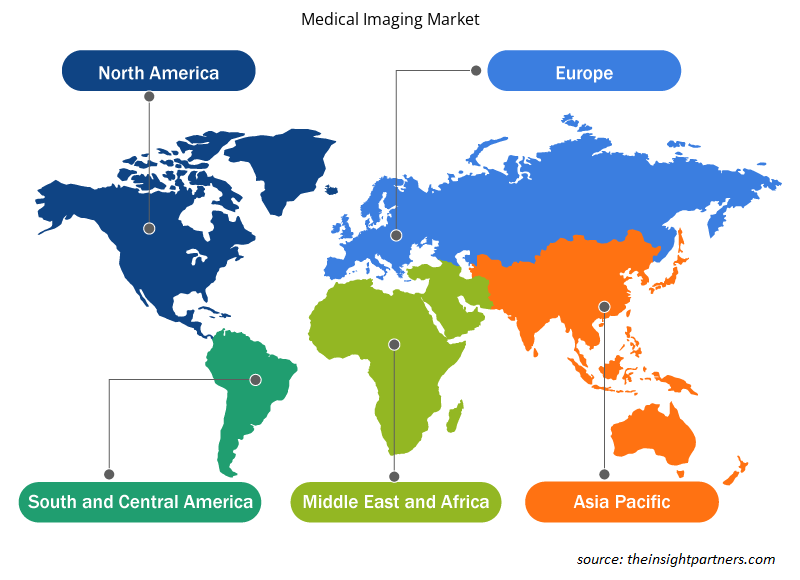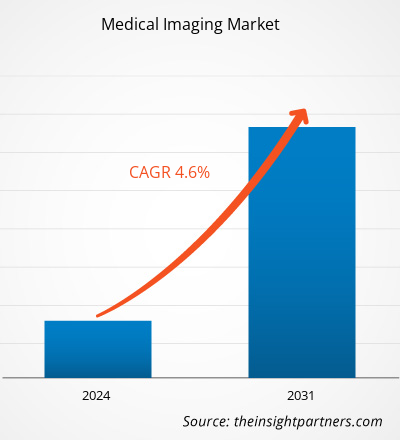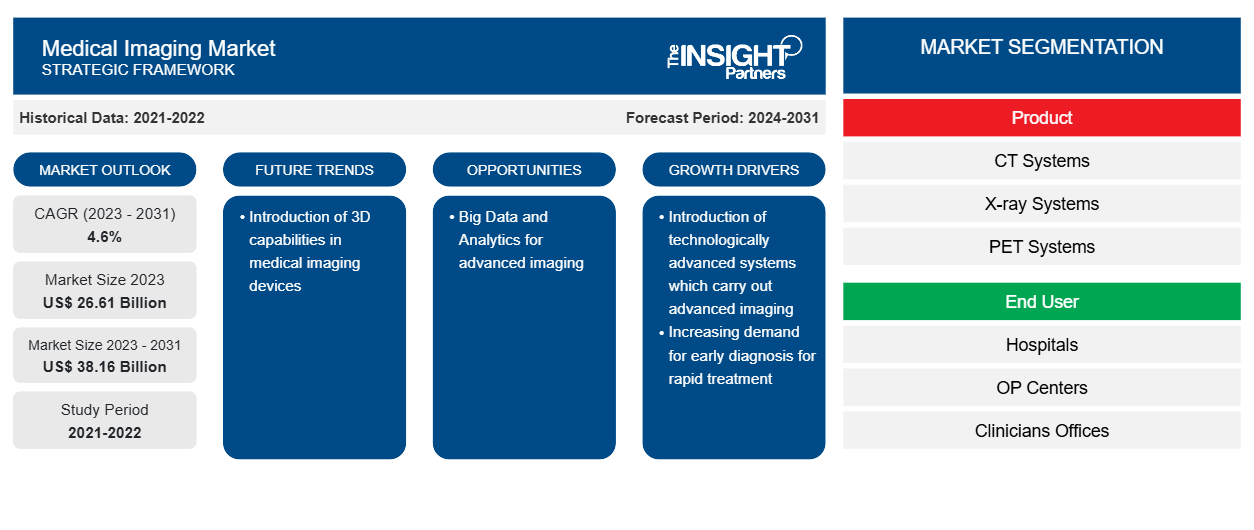Si prevede che la dimensione del mercato dell'imaging medico raggiungerà i 38,16 miliardi di dollari entro il 2031, rispetto ai 26,61 miliardi di dollari del 2023. Si prevede che il mercato registrerà un CAGR del 4,6% nel periodo 2023-2031. È probabile che l'introduzione di funzionalità 3D nei dispositivi di imaging medico rimanga una tendenza chiave nel mercato.
Analisi del mercato dell'imaging medico
La crescente domanda di diagnosi precoce delle malattie e l'ampliamento della portata delle applicazioni cliniche, la rapida crescita della popolazione geriatrica e il conseguente aumento della prevalenza delle malattie associate , i progressi tecnologici nel settore dell'imaging diagnostico e l'aumento di investimenti, fondi e sovvenzioni da parte di organizzazioni pubblico-private stanno alimentando la crescita del mercato dell'imaging medico. Inoltre, le iniziative governative per promuovere l'imaging medico per la prevenzione delle malattie, i crescenti investimenti in attività di R&S per lo sviluppo di imaging medico innovativo e la crescente adozione dell'imaging medico nei paesi in via di sviluppo stanno alimentando la crescita della quota di mercato.
Panoramica del mercato dell'imaging medico
Geograficamente, si prevede che l'Asia Pacifica registrerà il CAGR più elevato nel periodo di previsione 2023-2031. La crescente attenzione degli operatori di mercato all'introduzione di imaging medico tecnologicamente sviluppato per varie malattie sta alimentando la crescita del mercato. L'India è classificata tra i primi 20 produttori di dispositivi medici al mondo ed è il quarto produttore di dispositivi medici in Asia, seguito da Giappone, Cina e Corea del Sud. È probabile che il paese sperimenti una potenziale crescita sulla base della sua base di popolazione di oltre un miliardo, della consapevolezza della salute, della prosperità economica, delle competenze tecnologiche, dell'arricchimento del personale qualificato e dello sviluppo di strutture per la salute.
Personalizza questo report in base alle tue esigenze
Riceverai la personalizzazione gratuita di qualsiasi report, comprese parti di questo report, o analisi a livello nazionale, pacchetto dati Excel, oltre a usufruire di grandi offerte e sconti per start-up e università
-
Scopri le principali tendenze di mercato in questo rapporto.Questo campione GRATUITO includerà analisi di dati che spaziano dalle tendenze di mercato alle stime e alle previsioni.
Driver e opportunità del mercato dell'imaging medico
La crescente domanda di diagnosi precoce favorisce il mercato
I test diagnostici sono una componente cruciale del sistema sanitario, che fornisce informazioni essenziali per consentire ai fornitori e ai pazienti di prendere le giuste decisioni cliniche. Circa il 75% delle decisioni cliniche si basa su un test diagnostico. La domanda di accesso a diagnosi più rapide e accurate sta aumentando a un tasso del 10% all'anno, aumentando i costi e mettendo pressione sulla capacità e sulle competenze dei fornitori di servizi diagnostici. Dal punto di vista del paziente, la diagnosi e la diagnosi precoci possono prevenire inutili dolori e sofferenze. Possono anche ridurre la portata e il costo del trattamento. Un gran numero di ricerche collega la diagnosi precoce a benefici per la salute misurabili, come tassi di sopravvivenza migliorati e costi di trattamento inferiori. Inoltre, la consapevolezza del governo stimolerà ulteriormente la crescita del mercato. Ad esempio, le campagne Be Clear on Cancer mirano a migliorare la diagnosi precoce del cancro promuovendo la consapevolezza pubblica dei segni e dei sintomi del cancro e incoraggiando le persone a recarsi dal proprio medico di base senza indugio. Public Health England è responsabile del programma, in collaborazione con il Department of Health e NHS England. Pertanto, una crescente domanda di diagnosi precoce sta alimentando la crescita del mercato dell'imaging medico.
Big Data e Analytics rappresentano un'opportunità per la crescita del mercato
Secondo un articolo su ITN, Dhaval Shah e Prashanth Kollaikal di CitiusTech, che hanno discusso il potenziale dei big data nell'imaging diagnostico, hanno affermato che nuove e interessanti funzionalità nel sistema informativo radiologico (RIS) e nei sistemi PACS, in particolare quelli nel cloud. Queste potrebbero anche includere analisi e report impressionanti su dati operativi e clinici, come affermato nell'articolo. Gli indicatori chiave di prestazione (KPI) a livello aziendale sono derivati da una varietà di fonti. Questi KPI sono utilizzati generalmente per soddisfare le esigenze del fornitore e tenendo in considerazione l'efficienza clinica e operativa nonché il comfort del paziente. Sebbene questi KPI siano stati utilizzati per l'ottimizzazione per molti anni, l'efficienza complessiva può essere facilmente misurata e può essere migliorata con la competenza tecnologica dei dispositivi, modalità aumentate, sistemi software avanzati e dispositivi mobili. Pertanto, la crescente attenzione all'uso di dati di offerta e analisi nell'imaging medico funge da opportunità per la crescita del mercato dell'imaging medico.
Analisi della segmentazione del rapporto di mercato dell'imaging medico
I segmenti chiave che hanno contribuito alla derivazione dell'analisi di mercato dell'imaging medico sono il prodotto e l'utente finale.
- In base al prodotto, il mercato dell'imaging medico è suddiviso in sistemi CT, sistemi a raggi X, sistemi PET, sistemi MRI, sistemi a ultrasuoni e altri. Il segmento dei sistemi a raggi X ha detenuto la quota di mercato maggiore nel 2023.
- In base all'utente finale, il mercato dell'imaging medico è suddiviso in ospedali, centri OP, studi medici e centri di pronto soccorso. Il segmento ospedaliero ha detenuto la quota di mercato maggiore nel 2023.
Analisi della quota di mercato dell'imaging medico per area geografica
L'ambito geografico del rapporto sul mercato dell'imaging medico è suddiviso principalmente in cinque regioni: Nord America, Asia Pacifico, Europa, Medio Oriente e Africa, Sud e Centro America.
Il Nord America ha dominato il mercato. La crescita nel Nord America è caratterizzata dall'aumento della domanda di imaging medico e servizi da parte di ospedali e cliniche, dal crescente numero di pazienti sottoposti a procedure di imaging diagnostico, dall'elevata consapevolezza dei pazienti, da uno scenario di rimborso favorevole e dalla spesa più elevata in sanità. Inoltre, l'aumento della popolazione geriatrica, il crescente numero di malattie croniche e il crescente numero di centri di imaging diagnostico e medico tra i paesi della regione probabilmente spiegheranno la crescita del mercato dell'imaging medico nordamericano durante gli anni previsti. Gli Stati Uniti hanno molte cliniche di trattamento chirurgico avanzato e un numero crescente di procedure chirurgiche ortopediche. L'aumento della popolazione geriatrica è uno dei fattori per la crescita del mercato. L'aumento della popolazione anziana riflette una maggiore popolazione sottoposta a trattamenti medici. Si prevede che la crescente prevalenza del cancro aumenterà la domanda di dispositivi di imaging medico negli Stati Uniti.
Approfondimenti regionali sul mercato dell'imaging medico
Le tendenze regionali e i fattori che influenzano il mercato dell'imaging medico durante il periodo di previsione sono stati ampiamente spiegati dagli analisti di Insight Partners. Questa sezione discute anche i segmenti e la geografia del mercato dell'imaging medico in Nord America, Europa, Asia Pacifico, Medio Oriente e Africa e America centrale e meridionale.

- Ottieni i dati specifici regionali per il mercato dell'imaging medico
Ambito del rapporto sul mercato dell'imaging medico
| Attributo del report | Dettagli |
|---|---|
| Dimensioni del mercato nel 2023 | 26,61 miliardi di dollari USA |
| Dimensioni del mercato entro il 2031 | 38,16 miliardi di dollari USA |
| CAGR globale (2023-2031) | 4,6% |
| Dati storici | 2021-2022 |
| Periodo di previsione | 2024-2031 |
| Segmenti coperti |
Per Prodotto
|
| Regioni e Paesi coperti |
America del Nord
|
| Leader di mercato e profili aziendali chiave |
|
Densità degli attori del mercato dell'imaging medico: comprendere il suo impatto sulle dinamiche aziendali
Il mercato dell'imaging medico sta crescendo rapidamente, spinto dalla crescente domanda degli utenti finali dovuta a fattori quali l'evoluzione delle preferenze dei consumatori, i progressi tecnologici e una maggiore consapevolezza dei benefici del prodotto. Con l'aumento della domanda, le aziende stanno ampliando le loro offerte, innovando per soddisfare le esigenze dei consumatori e capitalizzando sulle tendenze emergenti, il che alimenta ulteriormente la crescita del mercato.
La densità degli operatori di mercato si riferisce alla distribuzione di aziende o società che operano in un particolare mercato o settore. Indica quanti concorrenti (operatori di mercato) sono presenti in un dato spazio di mercato in relazione alle sue dimensioni o al valore di mercato totale.
Le principali aziende che operano nel mercato dell'imaging medico sono:
- Compagnia elettrica generale
- Siemens AG
- Koninklijke Philips NV
- CORPORAZIONE SHIMADZU
- Hitachi, Ltd.
- Canone Inc.
Disclaimer : le aziende elencate sopra non sono classificate secondo un ordine particolare.

- Ottieni una panoramica dei principali attori del mercato dell'imaging medico
Notizie e sviluppi recenti del mercato dell'imaging medico
Il mercato dell'imaging medico viene valutato raccogliendo dati qualitativi e quantitativi post-ricerca primaria e secondaria, che includono importanti pubblicazioni aziendali, dati associativi e database. Di seguito sono elencati alcuni degli sviluppi nel mercato dell'imaging medico:
- FUJIFILM India ha ampliato il suo portafoglio di prodotti e soluzioni alla 75a Conferenza nazionale dell'Indian Radiological and Imaging Association (IRIA). Lanciati all'IRIA 2023, Arietta 850 DeepInsight e Arietta 650 DeepInsight sono le ultime offerte di tecnologia a ultrasuoni di FUJIFILM India. Il nuovo marchio di imaging "DeepInsight" è costituito da 5 elementi: accuratezza, riproducibilità, visibilità, efficienza e utilizzo dell'intelligenza artificiale. (Fonte: Fujifilm, sito Web aziendale, febbraio 2023)
- FUJIFILM Healthcare Americas Corporation ha ricevuto l'autorizzazione FDA 510(k) per il suo nuovo sistema di risonanza magnetica (MRI) da 1,5 Tesla, ECHELON Synergy. Il sistema impiega Synergy DLR, la tecnologia proprietaria di ricostruzione Deep Learning (DLR) di Fujifilm basata sull'intelligenza artificiale (AI), per migliorare la nitidezza delle immagini e acquisire scansioni più velocemente, contribuendo a una maggiore produttività, qualità delle immagini e soddisfazione del paziente. (Fonte: Fujifilm, sito Web aziendale, agosto 2023)
Copertura e risultati del rapporto sul mercato dell'imaging medico
Il rapporto "Dimensioni e previsioni del mercato dell'imaging medico (2021-2031)" fornisce un'analisi dettagliata del mercato che copre le seguenti aree:
- Dimensioni e previsioni del mercato dei kit per test rapidi a livello globale, regionale e nazionale per tutti i principali segmenti di mercato coperti dall'ambito
- Tendenze del mercato dei kit per test rapidi e dinamiche di mercato come conducenti, restrizioni e opportunità chiave
- Analisi dettagliata delle cinque forze PEST/Porter e SWOT
- Analisi di mercato dei kit per test rapidi che copre le principali tendenze del mercato, il quadro globale e regionale, i principali attori, le normative e i recenti sviluppi del mercato
- Analisi del panorama industriale e della concorrenza che copre la concentrazione del mercato, l'analisi della mappa di calore, i principali attori e gli sviluppi recenti per il mercato dell'imaging medico
- Profili aziendali dettagliati
- Analisi storica (2 anni), anno base, previsione (7 anni) con CAGR
- Analisi PEST e SWOT
- Valore/volume delle dimensioni del mercato - Globale, Regionale, Nazionale
- Industria e panorama competitivo
- Set di dati Excel
Report recenti
Rapporti correlati
Testimonianze
Motivo dell'acquisto
- Processo decisionale informato
- Comprensione delle dinamiche di mercato
- Analisi competitiva
- Analisi dei clienti
- Previsioni di mercato
- Mitigazione del rischio
- Pianificazione strategica
- Giustificazione degli investimenti
- Identificazione dei mercati emergenti
- Miglioramento delle strategie di marketing
- Aumento dell'efficienza operativa
- Allineamento alle tendenze normative























 Ottieni un campione gratuito per - Mercato dell'imaging medico
Ottieni un campione gratuito per - Mercato dell'imaging medico